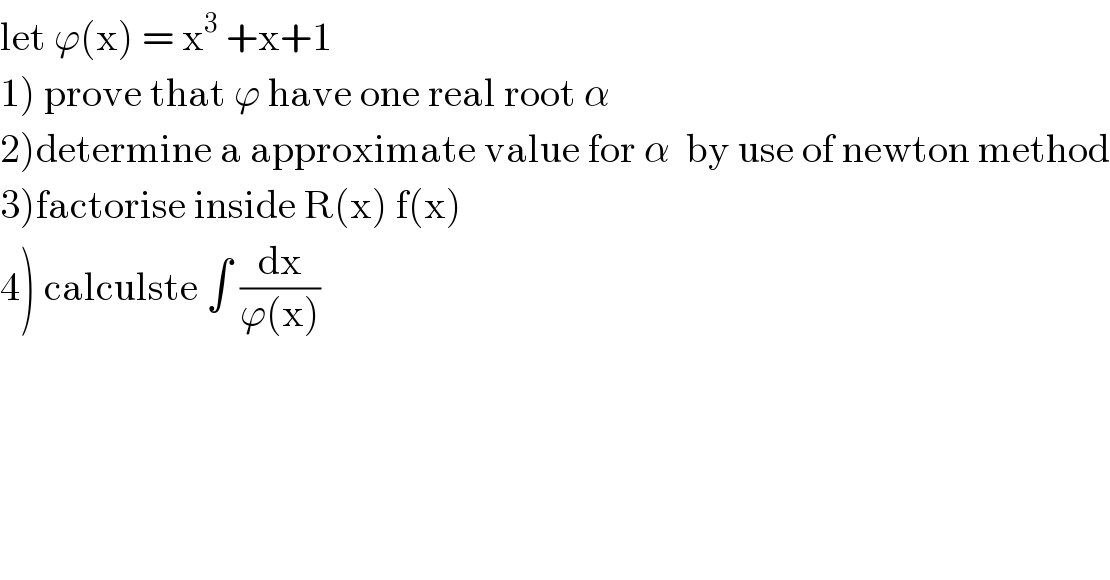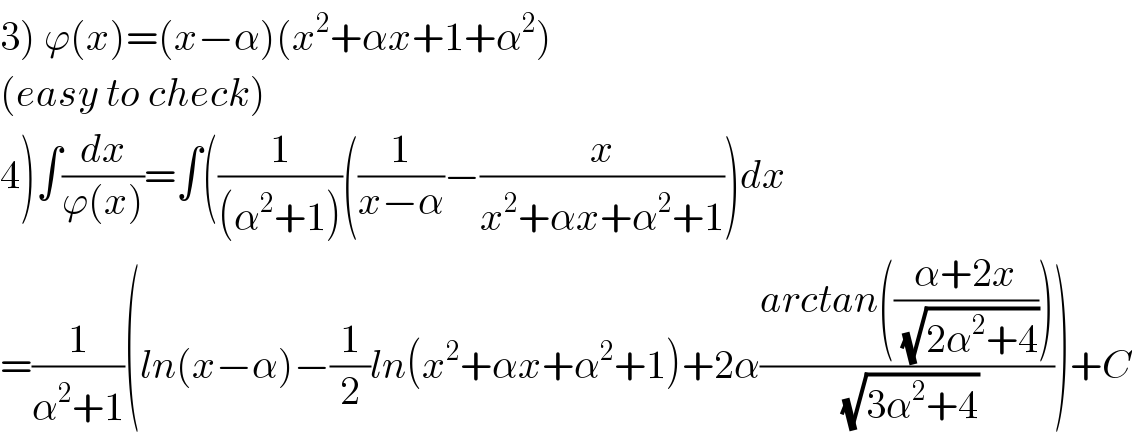
Previous in Relation and Functions Next in Relation and Functions
Question Number 104772 by mathmax by abdo last updated on 23/Jul/20

$$\mathrm{let}\:\varphi\left(\mathrm{x}\right)\:=\:\mathrm{x}^{\mathrm{3}} \:+\mathrm{x}+\mathrm{1} \\ $$$$\left.\mathrm{1}\right)\:\mathrm{prove}\:\mathrm{that}\:\varphi\:\mathrm{have}\:\mathrm{one}\:\mathrm{real}\:\mathrm{root}\:\alpha \\ $$$$\left.\mathrm{2}\right)\mathrm{determine}\:\mathrm{a}\:\mathrm{approximate}\:\mathrm{value}\:\mathrm{for}\:\alpha\:\:\mathrm{by}\:\mathrm{use}\:\mathrm{of}\:\mathrm{newton}\:\mathrm{method} \\ $$$$\left.\mathrm{3}\right)\mathrm{factorise}\:\mathrm{inside}\:\mathrm{R}\left(\mathrm{x}\right)\:\mathrm{f}\left(\mathrm{x}\right) \\ $$$$\left.\mathrm{4}\right)\:\mathrm{calculste}\:\int\:\frac{\mathrm{dx}}{\varphi\left(\mathrm{x}\right)} \\ $$
Answered by MAB last updated on 23/Jul/20
![1) ϕ′(x)=3x^2 +1>0 lim_(x→−∞) ϕ(x)=−∞ lim_(x→+∞) ϕ(x)=+∞ hence ϕ is a bijection of ]−∞,+∞[ to itself, ϕ has a unique real root 2)x_(n+1) =x_n −((ϕ(x_n ))/(ϕ′(x_n ))) x_(n+1) =x_n −((x_n ^3 +x_n +1)/(3x_n ^2 +1)) x_(n+1) =((2x_n ^3 −1)/(3x_n ^2 −1)) let x_0 =0 using python x_5 =−0.6823278039465127 to be continued...](Q104778.png)
$$\left.\mathrm{1}\right)\:\varphi'\left({x}\right)=\mathrm{3}{x}^{\mathrm{2}} +\mathrm{1}>\mathrm{0}\: \\ $$$$\underset{{x}\rightarrow−\infty} {\mathrm{lim}}\varphi\left({x}\right)=−\infty \\ $$$$\underset{{x}\rightarrow+\infty} {\mathrm{lim}}\varphi\left({x}\right)=+\infty \\ $$$$\left.{hence}\:\varphi\:{is}\:{a}\:{bijection}\:{of}\:\right]−\infty,+\infty\left[\:{to}\right. \\ $$$${itself},\:\varphi\:{has}\:{a}\:{unique}\:{real}\:{root} \\ $$$$\left.\mathrm{2}\right){x}_{{n}+\mathrm{1}} ={x}_{{n}} −\frac{\varphi\left({x}_{{n}} \right)}{\varphi'\left({x}_{{n}} \right)} \\ $$$${x}_{{n}+\mathrm{1}} ={x}_{{n}} −\frac{{x}_{{n}} ^{\mathrm{3}} +{x}_{{n}} +\mathrm{1}}{\mathrm{3}{x}_{{n}} ^{\mathrm{2}} +\mathrm{1}} \\ $$$${x}_{{n}+\mathrm{1}} =\frac{\mathrm{2}{x}_{{n}} ^{\mathrm{3}} −\mathrm{1}}{\mathrm{3}{x}_{{n}} ^{\mathrm{2}} −\mathrm{1}} \\ $$$${let}\:{x}_{\mathrm{0}} =\mathrm{0} \\ $$$${using}\:{python}\:{x}_{\mathrm{5}} =−\mathrm{0}.\mathrm{6823278039465127} \\ $$$${to}\:{be}\:{continued}... \\ $$$$ \\ $$
Commented by abdomsup last updated on 23/Jul/20

$${thank}\:{you}\:{sir}. \\ $$
Commented by MAB last updated on 23/Jul/20

$${you}\:{are}\:{welcome}\:{sir} \\ $$
Answered by MAB last updated on 23/Jul/20

$$\left.\mathrm{3}\right)\:\varphi\left({x}\right)=\left({x}−\alpha\right)\left({x}^{\mathrm{2}} +\alpha{x}+\mathrm{1}+\alpha^{\mathrm{2}} \right) \\ $$$$\left({easy}\:{to}\:{check}\right) \\ $$$$\left.\mathrm{4}\right)\int\frac{{dx}}{\varphi\left({x}\right)}=\int\left(\frac{\mathrm{1}}{\left(\alpha^{\mathrm{2}} +\mathrm{1}\right)}\left(\frac{\mathrm{1}}{{x}−\alpha}−\frac{{x}}{{x}^{\mathrm{2}} +\alpha{x}+\alpha^{\mathrm{2}} +\mathrm{1}}\right){dx}\right. \\ $$$$=\frac{\mathrm{1}}{\alpha^{\mathrm{2}} +\mathrm{1}}\left({ln}\left({x}−\alpha\right)−\frac{\mathrm{1}}{\mathrm{2}}{ln}\left({x}^{\mathrm{2}} +\alpha{x}+\alpha^{\mathrm{2}} +\mathrm{1}\right)+\mathrm{2}\alpha\frac{{arctan}\left(\frac{\alpha+\mathrm{2}{x}}{\sqrt{\mathrm{2}\alpha^{\mathrm{2}} +\mathrm{4}}}\right)}{\sqrt{\mathrm{3}\alpha^{\mathrm{2}} +\mathrm{4}}}\right)+{C} \\ $$
